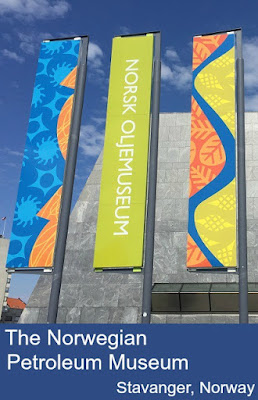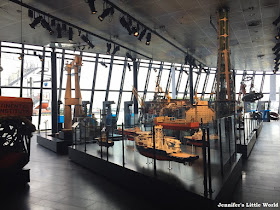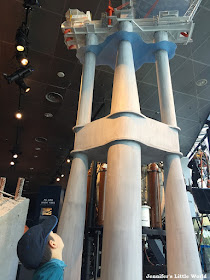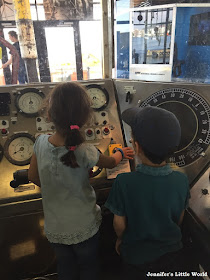The museum was very well designed for children. We watched a short introductory film which was very informative, and was hosted by cartoon character Petro the cat who also featured throughout the museum in the areas of particular interest to little ones. The children were also given a scavenger hunt with photographs of exhibits to spot during their visit. Some of them were quite tricky and so we all enjoyed taking part! When completed they were allowed to choose a small prize.
In the main hall there are lots of models of oil rigs and other machinery relating to the oil industry. There is also a life boat that you can climb inside as well as lots of other equipment to see and we spent a long time looking at all the detailed models.
Harry and I were both fascinated by this model of the Troll A platform, one of the greatest Norwegian engineering achievements of all time. This model is built to a 1:100 scale and the real structure measures 472 metres from the base of its skirts to the top of the flare boom. It's the tallest and heaviest human structure that has ever been moved into a different postition, and was towed into the North Sea in 1996. It was amazing to get a sense of just how tiny the platform on top is, compared to how much of the huge structure is hidden below the surface of the sea.
Like all good museums there were plenty of interactive exhibits and buttons to press, and because all the equipment is real it's much more exciting. Below is a control room where the children could press a button to start the drill, as well as examine all the other different levers, buttons and dials close up.
As well as the introductory video we also watched a short film showing deep sea divers working on an underwater pipe. It was really interesting to learn about the logistics of working at that depth under the water. Both films were shown hourly in English and all the museum signage was translated into English.
At the end the children had a great time in the play area, a little oil platform with a helicopter to climb into and lots of tunnels and ladders to explore.
After our visit, just outside the museum we found the Stavanger Geopark, an amazing play area made from recycled parts from the petroleum industry and decorated with brightly coloured graffiti. The children had a great time playing here, and I spent ages taking photos of all the installations!
We all learned a lot at the museum, and with the oil industry being so important to Norway it was a great introduction to the country. On our cruise on the way back to Dover we passed some oil rigs out at sea, and it was really interesting to see them being armed with a little more knowledge and understanding. I'd definitely recommend a visit!
You can read more about our day in Stavanger and what we got up to in the other ports on our cruise here.
We received complimentary entry to the museum in exchange for a review. A family ticket to the museum costs NOK 300 (approx. £25 at time of writing)








No comments:
Post a Comment
I love reading your comments!